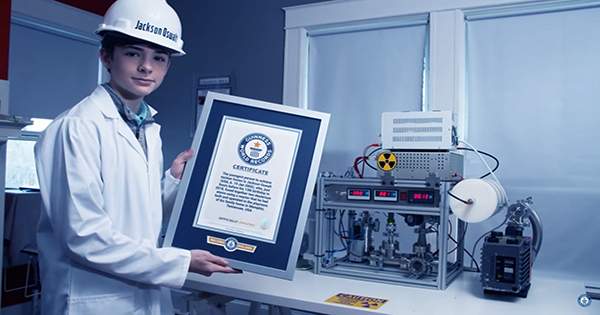With a miniature
setup built in the playroom of his parent’s home and a whole lot of brilliance,
Jackson Oswalt has just entered the Guinness Book of World Records as the
youngest person to ever accomplish nuclear fusion.
Hours
before turning 13 years old, Jackson succeeded in fusing two deuterium atoms
together in a small tabletop fusor built completely by himself. A fusor is a
device that uses an electric field to heat ions to extreme temperatures capable
of assisting nuclear fusion. Massive energy lure and ridiculous temperatures make
building homemade fusors a remarkable feat, but there is a booming online
community that makes it possible.
In his
home experiment based in Memphis, Tenessee, Jackson used his fusor to strike
atoms of deuterium, a stable isotope of hydrogen, to achieve nuclear fusion.
“I have
been able to use electricity to boost two atoms of deuterium together so that
they fuse together into an atom of helium 3, which also discharges a neutron
that can help to heat up water and turn a steam engine, which in turn generates
electricity,” described Jackson in the Guinness World Records video below.
Jackson
Oswalt explains his achievement. Guinness World Records
You might
be thinking that building a setup capable of nuclear fusion in your home is not
the best idea. Whilst you may be onto something, Jackson, now 15, is well aware
of the risks.
“Building
a fusor is a very dangerous method, usually because of the high electricity
that is used in the reactor. Precautions need to be taken, like wearing gloves
to shield me,” he said.
The
fusor is indeed not to be toyed with – according to Jackson, temperatures
inside can range to 100 million degrees Kelvin.
Appearing
in this year’s edition of Guinness Book of World Records 2021 for an achievement
achieved at the age of 12, the future is bright for the young enthusiast
physicist.
Fusors
are becoming public as an available mode of entry into nuclear fusion by
hobbyists. But it is not just people like young Jackson that use them – they
also have a commercial application. They are used by medical institutions to make
medical isotopes, which have a wide range of uses in diagnosis and testing, as
well as a source of neutrons by DaimlerChrysler Aerospace.
Unfortunately,
fusors are not probable to see commercial use to solve the world’s energy
needs. A common fusor cannot generate the neutron flux that a fusion reactor
would be able to, and the energy input far offsets the potential energy output
with technology as it stands.





0 Comments